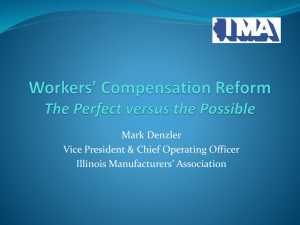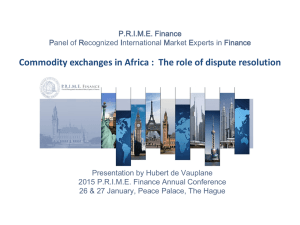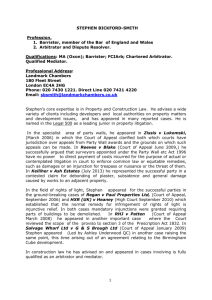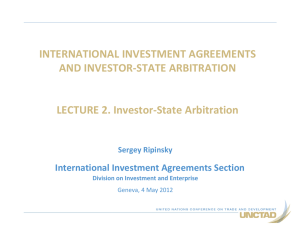Lessons and questions from a legal perspective
advertisement
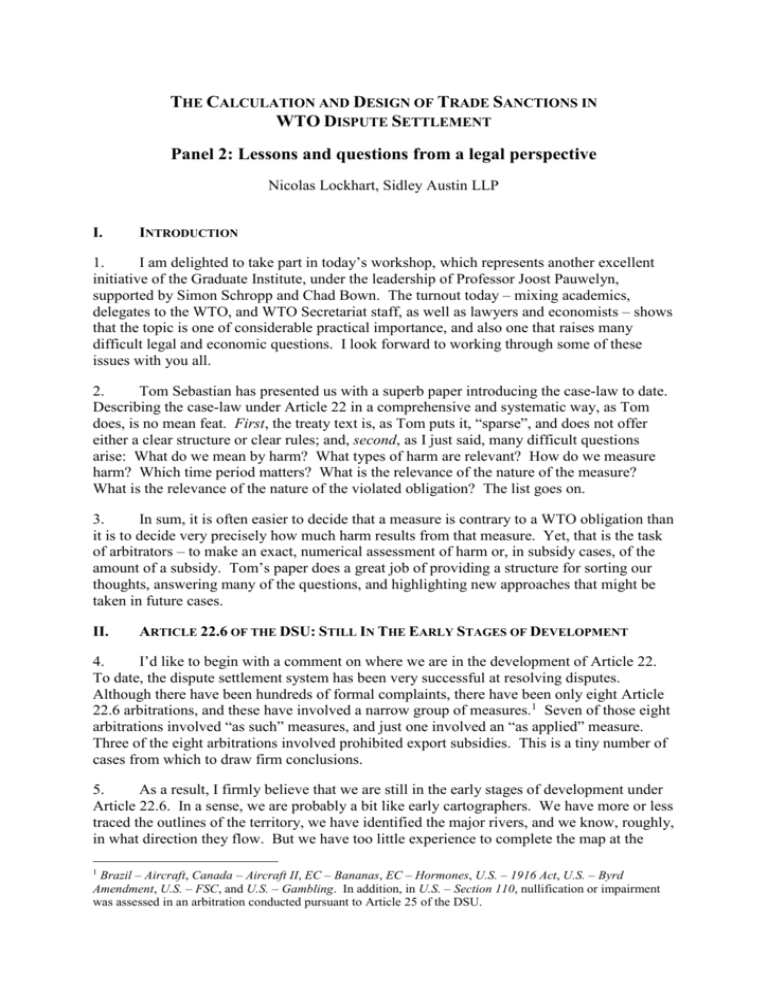
THE CALCULATION AND DESIGN OF TRADE SANCTIONS IN WTO DISPUTE SETTLEMENT Panel 2: Lessons and questions from a legal perspective Nicolas Lockhart, Sidley Austin LLP I. INTRODUCTION 1. I am delighted to take part in today’s workshop, which represents another excellent initiative of the Graduate Institute, under the leadership of Professor Joost Pauwelyn, supported by Simon Schropp and Chad Bown. The turnout today – mixing academics, delegates to the WTO, and WTO Secretariat staff, as well as lawyers and economists – shows that the topic is one of considerable practical importance, and also one that raises many difficult legal and economic questions. I look forward to working through some of these issues with you all. 2. Tom Sebastian has presented us with a superb paper introducing the case-law to date. Describing the case-law under Article 22 in a comprehensive and systematic way, as Tom does, is no mean feat. First, the treaty text is, as Tom puts it, “sparse”, and does not offer either a clear structure or clear rules; and, second, as I just said, many difficult questions arise: What do we mean by harm? What types of harm are relevant? How do we measure harm? Which time period matters? What is the relevance of the nature of the measure? What is the relevance of the nature of the violated obligation? The list goes on. 3. In sum, it is often easier to decide that a measure is contrary to a WTO obligation than it is to decide very precisely how much harm results from that measure. Yet, that is the task of arbitrators – to make an exact, numerical assessment of harm or, in subsidy cases, of the amount of a subsidy. Tom’s paper does a great job of providing a structure for sorting our thoughts, answering many of the questions, and highlighting new approaches that might be taken in future cases. II. ARTICLE 22.6 OF THE DSU: STILL IN THE EARLY STAGES OF DEVELOPMENT 4. I’d like to begin with a comment on where we are in the development of Article 22. To date, the dispute settlement system has been very successful at resolving disputes. Although there have been hundreds of formal complaints, there have been only eight Article 22.6 arbitrations, and these have involved a narrow group of measures.1 Seven of those eight arbitrations involved “as such” measures, and just one involved an “as applied” measure. Three of the eight arbitrations involved prohibited export subsidies. This is a tiny number of cases from which to draw firm conclusions. 5. As a result, I firmly believe that we are still in the early stages of development under Article 22.6. In a sense, we are probably a bit like early cartographers. We have more or less traced the outlines of the territory, we have identified the major rivers, and we know, roughly, in what direction they flow. But we have too little experience to complete the map at the Brazil – Aircraft, Canada – Aircraft II, EC – Bananas, EC – Hormones, U.S. – 1916 Act, U.S. – Byrd Amendment, U.S. – FSC, and U.S. – Gambling. In addition, in U.S. – Section 110, nullification or impairment was assessed in an arbitration conducted pursuant to Article 25 of the DSU. 1 moment because there are still major questions that have not been posed – far less resolved. For example, none of the disputes has, as yet, addressed a very basic measure involving excessive customs duties. I will return to this example in a moment. 6. A second point about today’s map is that arbitrators seem to approach each case very much on its own merits. They seem to be more interested in reaching an outcome they think is equitable on the facts than in establishing perfectly coherent case-law. As a result, the outlines of the map have not been traced in a uniform way. 7. What does this mean? My own conclusion is that we should read the case-law with an open mind, recognizing that is still a lot of unknown territory out there. We may well find that in five or ten years the map looks different. Indeed, the map may never be complete. III. CHOICE OF METRIC FOR ASSESSING NULLIFICATION OR IMPAIRMENT: PUNISHMENT SHOULD FIT THE CRIME THE 8. In four disputes, arbitrators assessed nullification or impairment using a metric based on “lost exports”.2 In two disputes, the metric was based on the direct “economic cost” sustained by commercial operators.3 4 This immediately raises questions: When is “lost exports”, rather than “economic cost”, the appropriate metric? Are these metrics mutually exclusive alternatives or can they be applied cumulatively? Are there other metrics that could be appropriate? 9. Nothing in the covered agreements specifies how nullification or impairment should be measured. Lost exports is not blessed as the default option; economic cost is not prescribed as an alternative; and no other metrics are excluded. Arbitrators, therefore, have a degree of discretion to select an appropriate metric. 10. So far, how have arbitrators decided what is an appropriate metric? To some extent, the approach may be captured by the maxim that the punishment should fit the crime. The crime scene here comprises the nature of the measure at issue and the nature of the obligation violated. Together, these two factors seem to influence the choice of metric. 11. In cases where the measure restricted the volume of exports from the retaliating Member, the metric was based on the value of the lost exports. The four measures were: an import ban (Hormones), a quota (Bananas), disbursements of duties to domestic producers (Byrd Amendment), and a ban on cross-border services (Gambling). 12. In cases where the measure resulted in direct economic costs for commercial operators, the metric was based on the amount of those costs. The two measures were: judicially sanctioned or litigation settlement payments by exporters (1916 Act) and lost royalties by copyright holders (Copyright). In these cases, there was no evidence that the measures had resulted in lost exports. EC – Bananas, EC – Hormones, U.S. – Byrd Amendment, and U.S. – Gambling. U.S. – 1916 Act and U.S. – Section 110 (nullification or impairment was assessed in an arbitration conducted pursuant to Article 25 of the DSU). 2 3 In prohibited subsidy cases, which I won’t discuss, the metric has been the “amount-of-subsidy” (Brazil – Aircraft, U.S. – FSC, and Canada – Aircraft II). 4 2 13. In the circumstances of these disputes, in view of the nature of the measures and the obligations violated, these metrics seem appropriate. However, given that they address just six measures, it is unlikely that these metrics exhaust the universe of appropriate metrics. 14. For example, there may be situations where it is appropriate to combine the two metrics. For example, imagine that a Member has a zero rate bound tariff, but imposes a 10 percent duty. In that case, the violation engenders two consequences. First, the tariff will restrict export volumes by a quantifiable amount that should be part of the calculus of nullification or impairment. This is harm in terms of trade that does not occur because of the measure. Second, despite the 10 percent tariff, imports may take place. Nonetheless, harm is sustained because duties are paid on this trade that does occur. The overpayment of duties is very much part of the nullification or impairment resulting from violation of the tariff binding, and must be included in the calculus. Thus, in this situation, the two metrics used separately in previous cases should be combined in some way. 15. Given that a basic tariff measure leads us to rethink how we apply the existing metrics, it is very likely that other measures will also make us look beyond the metrics that arbitrators have so far developed. In sum, different types of harm flow from different types of measure, violating different types of obligation. The metrics arbitrators have used so far are unlikely to capture all of these different types of harm. IV. THE CHOICE OF COUNTERFACTUAL: THE ARBITRATORS TEMPORARY SOLUTION MUST BE WTO-CONSISTENT 16. My second comment concerns the choice of counterfactual. This choice is crucially important because it sets the benchmark for assessing the level of harm caused by a WTOinconsistent measure. I agree fully with Tom that the benchmark for assessing harm must be a WTO-consistent counterfactual, and that the arbitrators in Gambling committed a serious error of law in refusing to ensure that their chosen counterfactual was WTO-consistent. 17. If an implementing Member fails to comply with WTO law, the retaliating Member is entitled to suspend concessions (or other obligations) up to the amount of nullification or impairment. The term nullification or impairment simply describes the amount of harm resulting from the violating Member’s failure to respect its WTO obligations. Unless the benchmark used to assess that harm is itself premised on market access under an unquestionably WTO-consistent counterfactual, the application of the benchmark will inevitably understate the value of market access in a WTO-consistent situation. 18. Unless arbitrators adhere to this principle, the DSB risks authorizing a solution to a dispute that understates the harm resulting from non-compliance because it is based on WTOinconsistent market access. Yet, common sense and the treaty text in Articles 3.6 and 21.5 of the DSU, and Article XVI:4 of the WTO Agreement, tell us that solutions to disputes must involve WTO-consistency. To this observer, the outcome in Gambling is, therefore, contrary to the treaty and represents bad policy. 19. I would suggest that the burden of proof has a role to play here. The burden is on the violating Member, which objects to the proposed level of suspension. To an extent, the choice of counterfactual is a factual matter and the burden of proof should, therefore, rest with the violating Member to demonstrate that its proposed counterfactual is appropriate. The violating Member must, therefore, bear the consequences of any doubts regarding the counterfactual. This seems eminently sensible, because the retaliating Member has already 3 proved once, and probably twice, that the violating Member is acting inconsistently with its WTO obligations, and the violating Member has failed to use the implementing period to comply. Any doubts should redound to the benefit of the retaliating Member. 20. I also strongly disagree with the arbitrator in Gambling that the arbitrator has no legal authority to resolve questions of the consistency of a counterfactual. The DSU vests arbitrators with a responsibility to find a temporary solution to a dispute; that solution must be based on a WTO-consistent assessment of the level of nullification or impairment caused by the violating Member. It is also hard to reconcile the decision in Gambling with the decision in Bananas, where the arbitrator found it could on the WTO consistency of an actual measure, and not merely a counterfactual. V. INSTITUTIONAL CONSIDERATIONS: IMPROVING THE INFORMATION AVAILABLE TO ARBITRATORS 21. The arbitrator in Gambling famously described its approach as being built on “shaky grounds solidly laid by the parties”.5 It described inadequacies in the data submitted, and lamented that the parties had “retained extreme positions, and failed to propose alternative solutions”.6 These uncommonly trenchant statements suggest a breakdown in the arbitral process: the arbitrator was not given the information it considered necessary. 22. The reasons for this failure may lie in the way arbitrations are conducted. Generally, the retaliating Member provides a brief “methodology” paper justifying the requested level of suspension. Each party then submits one written submission, followed by a hearing, and a single round of questions, answers and comments on the opposing party’s answers. 23. Compared to a panel process, which is much more drawn out, an Article 22.6 arbitration moves fast. There are fewer opportunities, and much less time, for the parties to develop wholly new methodologies. This makes it difficult for the parties to make major changes to their position in the later stages of the process. 24. In particular, under the current process, parties are unlikely to have either the time or inclination to change position dramatically in response to questions posed at the hearing for written reply thereafter. Further, even if wholly new positions were advocated at that stage, arbitrators would have no further chance to explore their questions on these new positions, nor would the opposing side have much time to respond to a wholly new position. Organizing the process in this way does not, therefore, provide the arbitrator with the surest foundations for its decision. 25. However, small changes to the current process may provide arbitrators with less “shaky” foundations for their decisions and, in turn, improve the consistency and quality of the decision-making. Because the DSU does not prescribe required steps in the process, the arbitrators control the process themselves, and can give the parties more time to address their concerns regarding methodologies and data. 26. For example, the arbitrators can – and, I believe, should – pose a first set of questions to the parties for written answer before the hearing. This would allow the arbitrators to communicate their concerns to the parties earlier in the process, and give the parties more 5 6 Award of the Arbitrator, U.S. – Gambling, para. 3.173. Award of the Arbitrator, U.S. – Gambling, para. 3.173. 4 time to develop their arguments. Also, where arbitrators would like the parties to move from “extreme positions”,7 and consider alternative methodologies, they should pose questions that directly ask about those alternatives. Posing clear questions earlier in the process would hopefully promote a better exchange of information and argument, without adding too much time to the process. Finally, if the arbitrators do not receive satisfactory answers, they should have the courage to draw adverse inferences and apply the burden of proof rigorously. 27. 7 Thank you. Award of the Arbitrator, U.S. – Gambling, para. 3.173. 5
